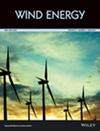分析风力激光雷达测量,量化陆上风力涡轮机的堵塞
IF 3.3
3区 工程技术
Q3 ENERGY & FUELS
引用次数: 1
摘要
摘要风力机转子在入风边界层(ABL)上引起的阻塞和加速等气流变化是影响风电场功率性能和年发电量(AEP)的重要因素。此外,这些旋翼诱导的对来风ABL的影响会随着来风的特征(如风切变、转向、湍流强度和涡轮机运行条件)而显著变化。为了更好地表征涡轮机转子与ABL之间相互作用的复杂流动物理特性,在陆上风力涡轮机阵列建造前后分别部署了剖面风激光雷达,进行了现场测试。考虑到这些转子引起的气流变化的幅度只占入射风速的一小部分(),因此对实验数据的分析和流量预测的生成需要达到很高的精度。此外,由场地地形和当地气候影响引起的气流扭曲需要量化,并与风力涡轮机转子引起的气流扭曲区分开来。为此,一套统计和机器学习模型,如k均值聚类分析与随机森林预测相结合,用于量化和预测不同风和大气条件下的流量变化。实验结果表明,在距领先转子1.5转子直径的上游距离处,风速降低幅度可达3%,且正风切变越大,影响更为显著。对于更复杂的风况,如负切变和低空射流,转子感应变得非常复杂,导致速度在轮毂高度以下降低(低至9%),在轮毂高度以上增加(高达3%)。在上游距离为3个转子直径时,转子感应对来风速度场的影响似乎已经大致可以忽略不计。该现场试验的结果将为模拟风力涡轮机和风电场运行的模型提供信息,提高了转子区域附近流量预测的准确性,这将有助于更准确地量化风电场堵塞及其对AEP的相对影响。本文章由计算机程序翻译,如有差异,请以英文原文为准。
Profiling wind LiDAR measurements to quantify blockage for onshore wind turbines
Abstract Flow modifications induced by wind turbine rotors on the incoming atmospheric boundary layer (ABL), such as blockage and speedups, can be important factors affecting the power performance and annual energy production (AEP) of a wind farm. Further, these rotor‐induced effects on the incoming ABL can vary significantly with the characteristics of the incoming wind, such as wind shear, veer, and turbulence intensity, and turbine operative conditions. To better characterize the complex flow physics underpinning the interaction between turbine rotors and the ABL, a field campaign was performed by deploying profiling wind LiDARs both before and after the construction of an onshore wind turbine array. Considering that the magnitude of these rotor‐induced flow modifications represents a small percentage of the incoming wind speed ( ), high accuracy needs to be achieved for the analysis of the experimental data and generation of flow predictions. Further, flow distortions induced by the site topography and effects of the local climatology need to be quantified and differentiated from those induced by wind turbine rotors. To this aim, a suite of statistical and machine learning models, such as k‐means cluster analysis coupled with random forest predictions, are used to quantify and predict flow modifications for different wind and atmospheric conditions. The experimental results show that wind velocity reductions of up to 3% can be observed at an upstream distance of 1.5 rotor diameter from the leading wind turbine rotor, with more significant effects occurring for larger positive wind shear. For more complex wind conditions, such as negative shear and low‐level jet, the rotor induction becomes highly complex entailing either velocity reductions (down to 9%) below hub height and velocity increases (up to 3%) above hub height. The effects of the rotor induction on the incoming wind velocity field seem to be already roughly negligible at an upstream distance of three rotor diameters. The results from this field experiment will inform models to simulate wind‐turbine and wind‐farm operations with improved accuracy for flow predictions in the proximity of the rotor area, which will be instrumental for more accurate quantification of wind farm blockage and relative effects on AEP.
求助全文
通过发布文献求助,成功后即可免费获取论文全文。
去求助
来源期刊

Wind Energy
工程技术-工程:机械
CiteScore
9.60
自引率
7.30%
发文量
0
审稿时长
6 months
期刊介绍:
Wind Energy offers a major forum for the reporting of advances in this rapidly developing technology with the goal of realising the world-wide potential to harness clean energy from land-based and offshore wind. The journal aims to reach all those with an interest in this field from academic research, industrial development through to applications, including individual wind turbines and components, wind farms and integration of wind power plants. Contributions across the spectrum of scientific and engineering disciplines concerned with the advancement of wind power capture, conversion, integration and utilisation technologies are essential features of the journal.
 求助内容:
求助内容: 应助结果提醒方式:
应助结果提醒方式:


